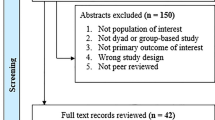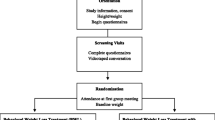Abstract
Background
Despite health and economic burdens associated with overweight and obesity, long-term weight loss intervention efforts have been largely unsuccessful. Observations that weight status tends to cluster in social groups, and findings showing “ripple” effects of weight change within social clusters, raise questions about the impact of social relationships on weight loss.
Purpose
Through a reanalysis of data from a randomized weight loss intervention, this study compared dyadic dynamics in intervention participants and in-home partners.
Methods
Over the course of 18 months, data was collected from 201 pairs enrolled in either behavioral weight loss treatment (BWL) or treatment including partners and providing items to facilitate healthy choices at home (BWL + H). Using a dyadic growth curve model, covariance between baseline BMI, BMI change trajectories, and starting BMI and BMI trajectory for both the self and the other were examined.
Results
There were strong indicators of dependence in the data. Baseline BMI was positively correlated for both treatment groups. In the BWL + H condition, BMI change trajectories were positively correlated. In the BWL condition, this reversed: Change trajectories were negatively correlated. Additionally, partner BMI and primary participant BMI change were positively correlated, indicating that a heavier partner at baseline related to less weight loss.
Conclusions
Social relationships exert a significant influence on weight loss outcomes. Depending on the intervention group, these influences may help (BWL + H) or hinder (BWL). It may be that home intervention changed social support and interaction in important ways and that these effects could be effectively harnessed to implement more effective interventions (NCT00200330).

Similar content being viewed by others
References
Finkelstein EA, Brown DS, Wrage LA, et al. Individual and aggregate years-of-life-lost associated with overweight and obesity. Obesity. 2010; 18(2): 333-339.
Fryar CD, Carroll MD, Ogden CL. Prevalence of overweight, obesity, and extreme obesity among adults: United States, trends 1960--1962 through 2009--2010. Natl Cent Health Stat. September 2012.
Ogden CL, Carroll MD, Kit BK, et al. Prevalence of obesity and trends in body mass index among us children and adolescents, 1999-2010. JAMA. 2012; 307(5): 483-490.
Ogden CL, Carroll MD, Kit BK, et al. Prevalence of childhood and adult obesity in the United States, 2011-2012. JAMA. 2014; 311(8): 806-814.
Xu F, Mawokomatanda T, Flegel D, et al. Surveillance for certain health behaviors among states and selected local areas—behavioral risk factor surveillance system, United States, 2011. Morb Mortal Wkly Rep Surveill Summ. 2014; 63(9): 1-149. Washington, D.C.: 2002.
Finkelstein EA, Khavjou OA, Thompson H, et al. Obesity and severe obesity forecasts through 2030. Am J Prev Med. 2012; 42(6): 563-570.
Wang YC, McPherson K, Marsh T, et al. Health and economic burden of the projected obesity trends in the USA and the UK. Lancet. 2011; 378(9793): 815-825.
Wadden TA, Butryn ML, Byrne KJ. Efficacy of lifestyle modification for long‐term weight control. Obes Res. 2001; 12(S12): 151S-162S.
Christakis NA, Fowler JH. The spread of obesity in a large social network over 32 years. N Engl J Med. 2007; 357(4): 370-379.
De la Haye K, Robins G, Mohr P, et al. Obesity-related behaviors in adolescent friendship networks. Soc Networks. 2010; 32(3): 161-167.
De la Haye K, Robins G, Mohr P, et al. Homophily and contagion as explanations for weight similarities among adolescent friends. J Adolesc Health. 2011; 49(4): 421-427.
Fletcher A, Bonell C, Sorhaindo A. You are what your friends eat: systematic review of social network analyses of young people's eating behaviours and bodyweight. J Epidemiol Community Health. 2011; 65(6): 548-555.
Hruschka DJ, Brewis AA, Wutich A, et al. Shared norms and their explanation for the social clustering of obesity. Am J Public Health. 2011; 101(S1): S295-S300.
Gorin AA, Wing RR, Fava JL, et al. Weight loss treatment influences untreated spouses and the home environment: evidence of a ripple effect. Int J Obes. 2008; 32(11): 1678-1684.
Schierberl Scherr AE, McClure Brenchley KJ, Gorin AA. Examining a ripple effect: do spouses’ behavior changes predict each other’s weight loss? J Obes. 2013; 1–8.
Golan R, Schwarzfuchs D, Stampfer MJ, et al. Halo effect of a weight-loss trial on spouses: the DIRECT-Spouse study. Public Health Nutr. 2010; 13(4): 544-549.
Rossini R, Moscatiello S, Tarrini G, et al. Effects of cognitive-behavioral treatment for weight loss in family members. J Am Diet Assoc. 2011; 111(11): 1712-1719.
Jackson SE, Steptoe A, Wardle J. The influence of partner’s behavior on health behavior change. JAMA Int Med. 2015; 175(3): 385-392.
Gorin AA, Raynor HA, Fava J, et al. Randomized controlled trial of a comprehensive home environment-focused weight-loss program for adults. Health Psychol. 2013; 32(2): 128-137.
Kenny DA, Kashy DA, Cook WL. Dyadic data analysis. New York, NY: The Guilford Press; 2006.
SPSS Inc. SPSS [computer program]. Version 22.0. Armonk, NY: IBM Corp; 2013.
Singer JD, Willet JB. Applied longitudinal data analysis: modeling change and event occurrence. New York, NY: Oxford. 2003.
Ellen JM. Social networks research and challenges to causal inference. J Adolesc Health. 2009; 45(2): 109-110.
McPherson M, Smith-Lovin L, Cook JM. Birds of a feather: homophily in social networks. Annu Rev Sociol. 2001; 27: 415-444.
Burke MA, Heiland FW, Nadler CM. From “overweight” to “about right”: evidence of a generational shift in body weight norms. Obesity. 2010; 18(6): 1226-1234.
Gorin AA, Powers TA, Koestner RK, et al. Autonomy support, self-regulation and weight loss. Health Psychol. 2014; 33(4): 332-339.
Powers TA, Koestner R, Gorin AA. Autonomy support from family and friends and weight loss in college women. Fam Syst Health. 2008; 26(4): 404-416.
Koestner R, Otis N, Powers TA, et al. Autonomous motivation, controlled motivation, and goal progress. J Pers. 2008; 76: 1201-1230.
Sorkin D, Mavandadi S, Rook KS, et al. Dyadic collaboration in shared health behavior change: the effects of a randomized trial to test a lifestyle intervention for high-risk Latinas. Health Psychol. 2014; 33(6): 566-575.
Gorin A. Weight loss for couples. In: ClinicalTrials.gov [Internet]. Bethesda (MD): National Library of Medicine (US). 2000- [cited 2015 Dec 5]. Available from: https://clinicaltrials.gov/ct2/show/NCT02570009 NLM Identifier: NCT02570009.
Author information
Authors and Affiliations
Corresponding author
Ethics declarations
Authors’ Statement of Conflict of Interest and Adherence to Ethical Standards
Talea Cornelius is funded on an NIH T-32 training grant. Katelyn Gettens is funded on an NIH grant (HL125157). Amy Gorin has received external grant funding from NIH, NHLBI (R21 HL125157; R01 HL77082), NICHD (R21 HD073966; R21 HD065185), Weight Watchers, NIAAA (R01AA021471), NIDDK (R01DK092374; U01 DK067861; R01 DK 57413; DK066787 S1), NINR (R01 NR07960), Science Applications International Corporation, Community Health Network of Connecticut, Aetna Foundation, National Cancer Institute, National Library of Medicine, and Obesity Society New Investigator Grant, and has consulted on NHLBI grants (R01 HL090864; R01 HL118208), NIDDK grants (R03 DK095959), NICHD grants (K23 HD057957), and NIMHD grants (R03 MH083987). She holds a secondary appointment as adjunct assistant professor at Brown Medical School in Providence, RI. She has also served as co-chair for the Society of Behavioral Medicine, Obesity and Eating Disorders Special Interest Group, and as a consultant for the Obesity Program at Connecticut Children’s Medical Center, in Hartford, CT. All procedures performed in studies involving human participants were in accordance with the ethical standards of the institutional and/or national research committee and with the 1964 Helsinki Declaration and its later amendments or comparable ethical standards.
All participants provided informed consent. Procedures were approved by the Miriam Hospital Institutional Review Board.
Funding
The original study was funded by NHLBI (HL77082).
Appendix
Appendix
*Unconditional growth model
**REML
MIXED BMI_A WITH Primary_A Partner_A CBMI_P CTime GROUP_BL Primary_Partner_BL_A SEX_0_1_A
/CRITERIA = CIN(95) MXITER(100) MXSTEP(65) SCORING(1) SINGULAR(0.000000000001) HCONVERGE(0,
ABSOLUTE) LCONVERGE(0, ABSOLUTE) PCONVERGE(0.000001, ABSOLUTE)
/FIXED = Primary_Partner_BL_A CTime Primary_Partner_BL_A*CTime | SSTYPE(3)
/METHOD = REML
/PRINT = SOLUTION TESTCOV
/RANDOM = Primary_A Partner_A Primary_A*CTime Partner_A*CTime | SUBJECT(CoupleID) COVTYPE(UNR)
/REPEATED = Primary_Partner_BL_A | SUBJECT(CoupleID*CTime) COVTYPE(CSH).
**ML for chi square comparison
MIXED BMI_A WITH Primary_A Partner_A CBMI_P CTime GROUP_BL Primary_Partner_BL_A SEX_0_1_A
/CRITERIA = CIN(95) MXITER(100) MXSTEP(65) SCORING(1) SINGULAR(0.000000000001) HCONVERGE(0,
ABSOLUTE) LCONVERGE(0, ABSOLUTE) PCONVERGE(0.000001, ABSOLUTE)
/FIXED = Primary_Partner_BL_A CTime Primary_Partner_BL_A*CTime | SSTYPE(3)
/METHOD = ML
/PRINT = SOLUTION TESTCOV
/RANDOM = Primary_A Partner_A Primary_A*CTime Partner_A*CTime | SUBJECT(CoupleID) COVTYPE(UNR)
/REPEATED = Primary_Partner_BL_A | SUBJECT(CoupleID*CTime) COVTYPE(CSH).
*Conditional Model
**REML
MIXED BMI_A WITH Primary_A Partner_A CBMI_P CTime GROUP_BL Primary_Partner_BL_A SEX_0_1_A
/CRITERIA = CIN(95) MXITER(100) MXSTEP(65) SCORING(1) SINGULAR(0.000000000001) HCONVERGE(0,
ABSOLUTE) LCONVERGE(0, ABSOLUTE) PCONVERGE(0.000001, ABSOLUTE)
/FIXED = GROUP_BL CTime SEX_0_1_A Primary_Partner_BL_A CTime*GROUP_BL CTime*Primary_Partner_BL_A
CTime*SEX_0_1_A GROUP_BL*Primary_Partner_BL_A GROUP_BL*SEX_0_1_A Primary_Partner_BL_A*SEX_0_1_A
CTime*GROUP_BL*Primary_Partner_BL_A CTime*GROUP_BL*SEX_0_1_A CTime*Primary_Partner_BL_A*SEX_0_1_A
GROUP_BL*Primary_Partner_BL_A*SEX_0_1_A GROUP_BL*Primary_Partner_BL_A*SEX_0_1_A*CTime | SSTYPE(3)
/METHOD = REML
/PRINT = SOLUTION TESTCOV
/RANDOM = Primary_A Partner_A Primary_A*CTime Partner_A*CTime | SUBJECT(CoupleID) COVTYPE(UNR)
/REPEATED = Primary_Partner_BL_A | SUBJECT(CoupleID*CTime) COVTYPE(CSH).
**ML
MIXED BMI_A WITH Primary_A Partner_A CBMI_P CTime GROUP_BL Primary_Partner_BL_A SEX_0_1_A
/CRITERIA = CIN(95) MXITER(100) MXSTEP(65) SCORING(1) SINGULAR(0.000000000001) HCONVERGE(0,
ABSOLUTE) LCONVERGE(0, ABSOLUTE) PCONVERGE(0.000001, ABSOLUTE)
/FIXED = GROUP_BL CTime SEX_0_1_A Primary_Partner_BL_A CTime*GROUP_BL CTime*Primary_Partner_BL_A
CTime*SEX_0_1_A GROUP_BL*Primary_Partner_BL_A GROUP_BL*SEX_0_1_A Primary_Partner_BL_A*SEX_0_1_A
CTime*GROUP_BL*Primary_Partner_BL_A CTime*GROUP_BL*SEX_0_1_A CTime*Primary_Partner_BL_A*SEX_0_1_A
GROUP_BL*Primary_Partner_BL_A*SEX_0_1_A GROUP_BL*Primary_Partner_BL_A*SEX_0_1_A*CTime | SSTYPE(3)
/METHOD = ML
/PRINT = SOLUTION TESTCOV
/RANDOM = Primary_A Partner_A Primary_A*CTime Partner_A*CTime | SUBJECT(CoupleID) COVTYPE(UNR)
/REPEATED = Primary_Partner_BL_A | SUBJECT(CoupleID*CTime) COVTYPE(CSH).
*Final Model
**REML
MIXED BMI_A WITH Primary_A Partner_A CBMI_P CTime GROUP_BL Primary_Partner_BL_A SEX_0_1_A CTimeSq
/CRITERIA = CIN(95) MXITER(100) MXSTEP(65) SCORING(1) SINGULAR(0.000000000001) HCONVERGE(0,
ABSOLUTE) LCONVERGE(0, ABSOLUTE) PCONVERGE(0.000001, ABSOLUTE)
/FIXED = GROUP_BL CTime Primary_Partner_BL_A SEX_0_1_A CTimeSq CTime*GROUP_BL
CTime*Primary_Partner_BL_A CTime*SEX_0_1_A CTimeSq*Primary_Partner_BL_A
GROUP_BL*Primary_Partner_BL_A GROUP_BL*SEX_0_1_A Primary_Partner_BL_A*SEX_0_1_A
CTime*GROUP_BL*Primary_Partner_BL_A CTime*GROUP_BL*SEX_0_1_A CTime*Primary_Partner_BL_A*SEX_0_1_A
GROUP_BL*Primary_Partner_BL_A*SEX_0_1_A
CTime*GROUP_BL*Primary_Partner_BL_A*SEX_0_1_A | SSTYPE(3)
/METHOD = REML
/PRINT = SOLUTION TESTCOV
/RANDOM = Primary_A Partner_A Primary_A*CTime Partner_A*CTime | SUBJECT(CoupleID) COVTYPE(UNR)
/REPEATED = Primary_Partner_BL_A | SUBJECT(CoupleID*CTime) COVTYPE(CSH).
**ML
MIXED BMI_A WITH Primary_A Partner_A CBMI_P CTime GROUP_BL Primary_Partner_BL_A SEX_0_1_A CTimeSq
/CRITERIA = CIN(95) MXITER(100) MXSTEP(65) SCORING(1) SINGULAR(0.000000000001) HCONVERGE(0,
ABSOLUTE) LCONVERGE(0, ABSOLUTE) PCONVERGE(0.000001, ABSOLUTE)
/FIXED = GROUP_BL CTime Primary_Partner_BL_A SEX_0_1_A CTimeSq CTime*GROUP_BL
CTime*Primary_Partner_BL_A CTime*SEX_0_1_A CTimeSq*Primary_Partner_BL_A
GROUP_BL*Primary_Partner_BL_A GROUP_BL*SEX_0_1_A Primary_Partner_BL_A*SEX_0_1_A
CTime*GROUP_BL*Primary_Partner_BL_A CTime*GROUP_BL*SEX_0_1_A CTime*Primary_Partner_BL_A*SEX_0_1_A
GROUP_BL*Primary_Partner_BL_A*SEX_0_1_A
CTime*GROUP_BL*Primary_Partner_BL_A*SEX_0_1_A | SSTYPE(3)
/METHOD = ML
/PRINT = SOLUTION TESTCOV
/RANDOM = Primary_A Partner_A Primary_A*CTime Partner_A*CTime | SUBJECT(CoupleID) COVTYPE(UNR)
/REPEATED = Primary_Partner_BL_A | SUBJECT(CoupleID*CTime) COVTYPE(CSH).
*Split by condition - quadratic
MIXED BMI_A WITH Primary_A Partner_A CBMI_P CTime Primary_Partner_BL_A SEX_0_1_A CTimeSq
/CRITERIA = CIN(95) MXITER(100) MXSTEP(65) SCORING(1) SINGULAR(0.000000000001) HCONVERGE(0,
ABSOLUTE) LCONVERGE(0, ABSOLUTE) PCONVERGE(0.000001, ABSOLUTE)
/FIXED = CTime Primary_Partner_BL_A SEX_0_1_A CTimeSq
CTime*Primary_Partner_BL_A CTime*SEX_0_1_A CTimeSq*Primary_Partner_BL_A Primary_Partner_BL_A*SEX_0_1_A
CTime*Primary_Partner_BL_A*SEX_0_1_A | SSTYPE(3)
/METHOD = REML
/PRINT = SOLUTION TESTCOV
/RANDOM = Primary_A Partner_A Primary_A*CTime Partner_A*CTime | SUBJECT(CoupleID) COVTYPE(UNR)
/REPEATED = Primary_Partner_BL_A | SUBJECT(CoupleID*CTime) COVTYPE(CSH).
About this article
Cite this article
Cornelius, T., Gettens, K. & Gorin, A.A. Dyadic Dynamics in a Randomized Weight Loss Intervention. ann. behav. med. 50, 506–515 (2016). https://doi.org/10.1007/s12160-016-9778-8
Published:
Issue Date:
DOI: https://doi.org/10.1007/s12160-016-9778-8




